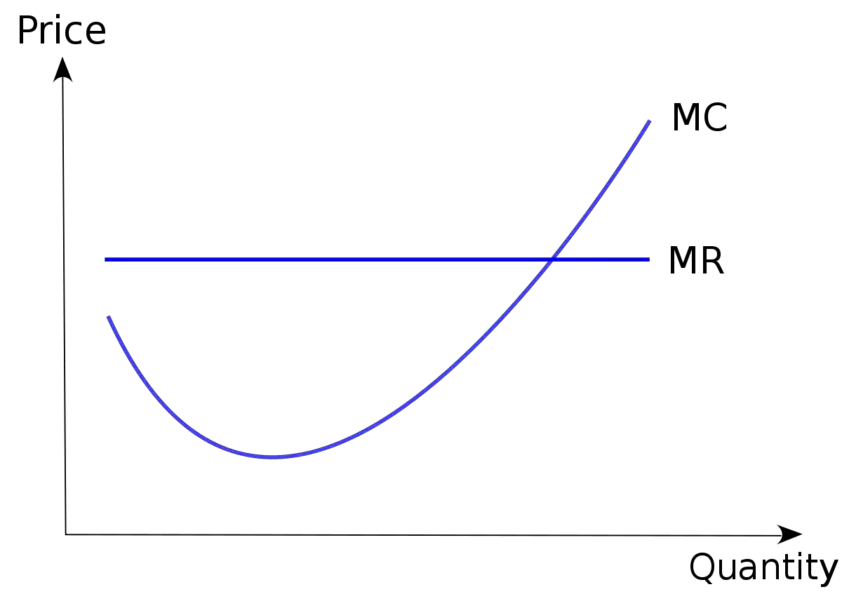Table of Contents ![]()
Marginal Revenue: How to Calculate with Formula & Example

Marginal Revenue Definition
Marginal Revenue is the money a firm makes for each additional sale. In other words, it determines how much a firm would receive from selling one further good. For example, if a baker sells an additional loaf of bread for $2, then their marginal revenue is also $2.
Key Points
- Marginal Revenue is the money the firm brings in from each additional sale that it makes.
- When Marginal Revenue equals Marginal Cost, we have what is known as profit maximization.
- Marginal Revenue can be calculated by dividing the change in revenue by the change in price.
Marginal Revenue is an important concept as it allows profit-maximizing businesses to identify when to stop producing further products. For example, when Marginal Revenue exceeds Marginal Cost, it becomes a net loss for the business. This is because it is costing the firm more to produce an additional unit than it is receiving from its sale.
That is to say, the firm loses money by producing more. This can happen to big businesses as they start to suffer from diseconomies of scale (where they start becoming less productive due to their increased size).
Marginal Revenue Formula
A company calculates Marginal Revenue by dividing the change in revenue by the change in quantity. For example, a company that increases production by 100 units receives $100 in revenue. By dividing the 100 units by $100, the marginal revenue is calculated.

In other words, MR is calculated by dividing the change in total revenue by the change in total output quantity. Therefore, we can look at each additional item sold as MR.
For example, a firm may sell 50 products for $500. If the 51st item sells for $6, then its MR is also $6. As a result, the average price of $10 is ignored, with MR only looking at the next item sold or the incremental change.
Marginal Revenue Example
Marginal Revenue (MR) is the money a firm makes for each additional unit sold. For example, when a consumer goes to Walmart and pays $20 in groceries, that is MR – because the groceries purchased were new and marginal sales.
So anything sold can be considered as MR. However, the purpose of MR is to calculate the change in revenue after a certain point. For example, there is a business called Bobs Bicycles that sells bicycles. The company usually sells 100 bikes a week for $50,000. Bobs Bicycles undertakes a promotional campaign that boosts sales to 120 bikes a week, earning the company a total of $70,000.
In this example, total revenue increased from $50,000 to $70,000, meaning revenue increase by $20,000. At the same time, the quantity sold increased from 100 to 120, meaning an increase of 20. So revenue increased by $20,000 and quantity by 20. We therefore divide revenue ($20,000) by quantity (20), to get $1,000. So the MR achieved from each sale was $1,000.
This calculation is important for businesses as they need to ensure that MR does not fall below Marginal Cost (MC). When it does, it means that the business is losing money – because it is costing more than what it is able to sell the product or service for.
Marginal Revenue Curve
Marginal Revenue is shortened to ‘MR’ in economics to make it easier to view on charts. As we can see below, MR is stable and consistent. This is because, for each good sold, the business makes the exact same amount from each customer. By contrast, Marginal Cost (MC) can vary. Some businesses may benefit from economies of scale, which lower its costs.
However, businesses may also experience an increased level of inefficiencies. This may just be just bad business management, or it could suffer from diseconomies of scale. In turn, MC starts to increase. As we can see from the chart, there is a point where MR and MC intersect. It is at this point where it becomes unprofitable for the business to produce any more.

Marginal Revenue and Marginal Cost
When Marginal Revenue (the money a firm makes from each additional sale) equals Marginal Cost (the amount it costs a firm to produce an additional unit), firms will stop producing the product / service. So when MR is larger than Marginal Cost (MC), then the firm is making money.

When MC = MR, we have what is known as profit maximisation. After this point has been reached; the firm cannot make any more profit. It is therefore in their interest to stop production.
FAQs
Marginal Revenue is the money a firm makes for each additional sale. In other words: it is the calculation used to determine how much a firm would receive from selling one further product or service.
Marginal revenue (MR) is calculated by dividing the change in total revenue by the change in total output quantity. Therefore, we can look at each additional item sold as MR. For instance, a firm may sell 50 products for $500. If the 51st item sells for $6, then its MR is also $6. As a result, the average price of $10 is ignored, with MR only looking at the next item sold or the incremental change.
There is a business called Bobs Bicycles that sells….. bicycles. The company usually sells 100 bikes a week for $50k . Bobs Bicycles undertakes a promotional campaign which boosts sales to 120 bikes a week; earning the company a total of $70,000.
In this example, total revenue increased from $50,000 to $70,000; meaning revenue increase by $20,000. At the same time, the quantity sold increased from 100 to 120; meaning an increase in quantity of 20. So revenue increased by $20,000 and quantity by 20. We therefore divide revenue ($20,000) by quantity (20), to get $1,000. So the marginal revenue achieved from the sale was $1,000.
Marginal revenue is a component of total revenue. When a company sells more units of a product, the total revenue increases, and the marginal revenue is the additional revenue generated by selling the last unit.
About Paul
Paul Boyce is an economics editor with over 10 years experience in the industry. Currently working as a consultant within the financial services sector, Paul is the CEO and chief editor of BoyceWire. He has written publications for FEE, the Mises Institute, and many others.

Related Topics
Further Reading
 Aggregate Demand: Definition, Components & Examples - Aggregate demand refers to all the goods produced and brought within the economy. Economists calculate this using values at a…
Aggregate Demand: Definition, Components & Examples - Aggregate demand refers to all the goods produced and brought within the economy. Economists calculate this using values at a…  Human Capital: Definition, Examples, Pros & Cons - Human capital refers to the skills, habits, and other attributes each person possesses.
Human Capital: Definition, Examples, Pros & Cons - Human capital refers to the skills, habits, and other attributes each person possesses.  Economic Efficiency - Economic efficiency refers to the optimal allocation of resources to maximize overall welfare or output.
Economic Efficiency - Economic efficiency refers to the optimal allocation of resources to maximize overall welfare or output. 